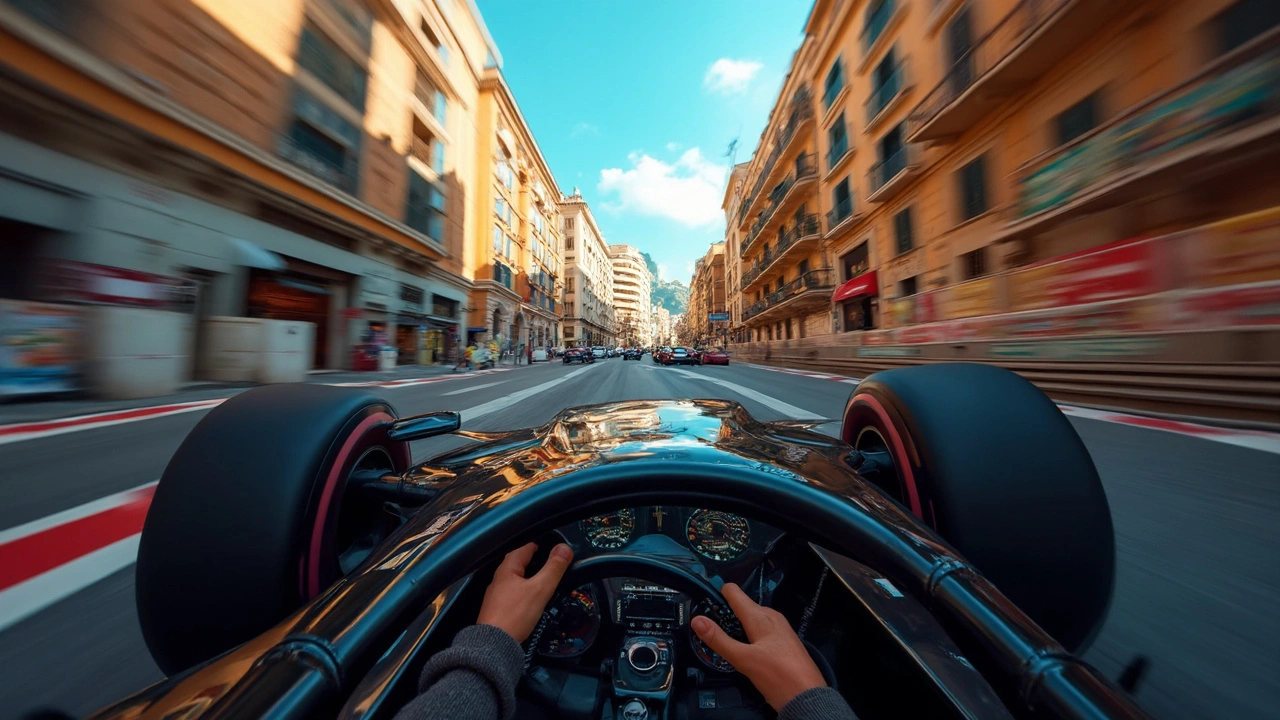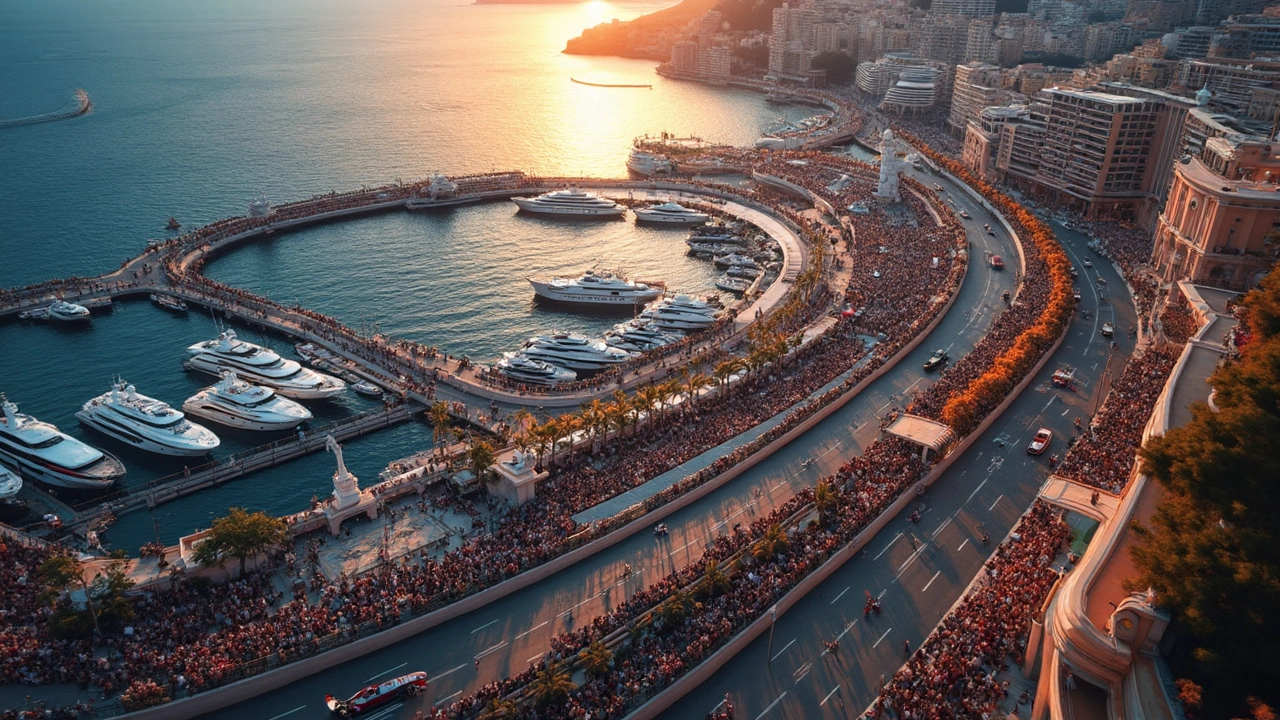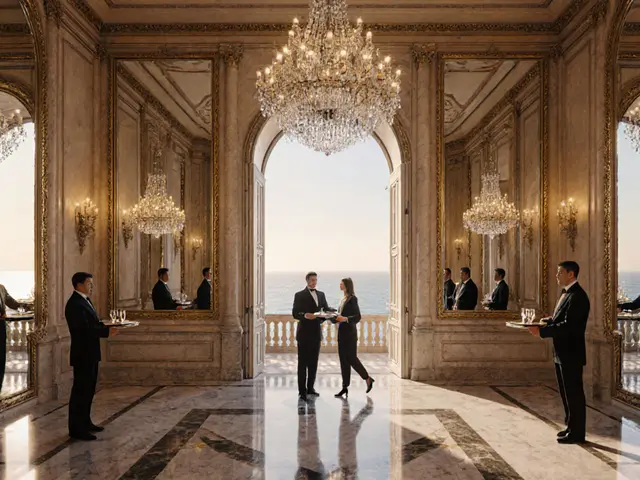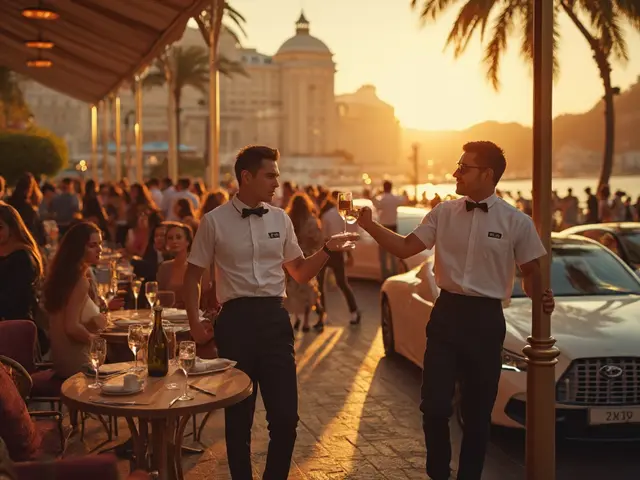If you ask an F1 driver, the Monaco Grand Prix isn’t just another race. It’s the wildest balancing act in the sport—slick turns, zero room for mistakes, all jammed into two hours on a street that’s barely wide enough for a family car. You’ll hear veterans call it a 'dance' because, in Monaco, even one tiny misstep means a busted car and a long walk home. There’s no other circuit where focus and guts matter more.
People dream of coming to Monaco for a reason. The place oozes history. Cars fly past the harbor where billionaires watch from their yachts. It’s the only race where fans stand right next to the action, separated from the drivers by nothing but a metal fence and a little courage. Getting tickets is almost as tricky as the race itself, but just being in town during GP week feels like a win.
- Why Monaco Feels Like a Dance Floor, Not a Racetrack
- Wild Facts That Make Monaco Unique
- How to Watch (And Actually Enjoy) the Monaco GP
- Party Vibes and Celebrity Sightings
- Local Tips for First-Timers in Monaco
Why Monaco Feels Like a Dance Floor, Not a Racetrack
The Grand Prix de Monaco isn’t just tight—it’s extreme. Monaco’s track is barely 3.34 km long, which means it’s not even the shortest on the F1 calendar (that’s Austria), but the corners here are in another league. Famous turns like the Fairmont Hairpin are so sharp, drivers slow down to about 50 km/h—barely faster than a city bus. And the barriers? They’re a few inches away, not forgiving at all if you mess up a move.
Why do drivers call it a dance? Because racing here is all about tiny, perfect movements. One slip and the car’s in the wall. There’s no big straight section to relax, just bend after bend, with zero room to overtake. In fact, in the last ten years, there were whole races where not a single on-track pass for the lead happened. You have to respect the rhythm or you’re done.
This street circuit is used by regular cars the rest of the year, which means lots of bumps and changing grip. Drivers switch their steering wheels 50 times per lap—more than anywhere else. Here’s a quick look at what they have to deal with:
- 19 turns packed into each lap
- Elevation changes of over 40 meters
- Potholes, faded paint lines, and manhole covers—they’re all part of the challenge
It’s not just about speed. The fastest lap in Monaco history? 1:10.166, set by Lewis Hamilton in 2019. But winning is about precision, not raw power. Qualifying is king because passing is nearly impossible. You’ll see the world’s best drivers sweating over getting every single curve exactly right—and that’s why they say Monaco is all about the dance, not just the drive.
Wild Facts That Make Monaco Unique
The Grand Prix de Monaco is like nothing else in F1. This race throws out the normal playbook. Forget big, wide tracks—Monaco is just 3.337 km of tight city streets, crammed between barriers and luxury real estate. Its tiny streets force drivers to run super-close to the walls at 280km/h, and honestly, you won’t see skill like this anywhere else on the calendar.
The track has been almost unchanged since its first race in 1929. That means it’s so narrow that two modern F1 cars can barely run side by side. Want stats? Most years, overtaking basically doesn’t happen here—last year, only 16 on-track overtakes happened during the whole race. Compare that to over 50 at a place like Silverstone. Strategy and qualifying matter more than outright racing.
Drivers call Monaco the 'jewel in the crown,' but it’s murder on their bodies. With over 4,000 gear changes per race, plus endless turns (there are 19 in total), it’s the most draining grand prix for drivers mentally and physically. Miss one braking point at Sainte Dévote or Rascasse, and you’re in the wall—no run-off.
Another fun fact: Monaco pays nothing to host the race. Unlike other venues that fork out tens of millions, this tiny city-state hosts the Monaco GP for free because F1 can’t resist the glamour and history. It’s the only F1 event where drivers walk to the track from their hotels. Where else does Daniel Ricciardo walk to work in flip flops before qualifying?
There’s no permanent pit building, so organizers rebuild everything each year just for this one weekend. The close-up view for fans is unbeatable—stand anywhere trackside and you’re just a few feet from the action. The Monaco race is the slowest on the F1 calendar, but that doesn’t make it easy. Precision matters more than speed around here, and that’s what makes it awesome.
| Quick Stats: Monaco GP | Details |
|---|---|
| Track Length | 3.337 km |
| Corners | 19 |
| First Race | 1929 |
| Pit Lane Speed Limit | 60 km/h |
| F1 Cars Overtaking Average | 10-16 per race |
So, if you want to see F1 drivers truly tested, the Grand Prix de Monaco is the spot. No other race pushes so hard or puts you this close to the heart-pounding action.

How to Watch (And Actually Enjoy) the Monaco GP
If you plan to see the Grand Prix de Monaco up close, forget about sprawling grandstands—you might end up leaning over a balcony or pressed by a fence. The track is packed tight into the city’s streets, and sightlines are as rare as a traffic-free weekday in Monaco. TV coverage shows every angle, but nothing beats the energy in person. Here’s how to actually enjoy the racing, whether you’re in the city or chilling at home:
- Pick your viewing spot carefully. Grandstand K gives an awesome view of the harbor and the famous Tabac and Swimming Pool corners—lots of action happens there. Grandstand B is legendary because it overlooks Place du Casino, where cars slither through the city’s flashiest turn.
- Yacht parties are real, but not just for billionaires. Some event companies offer single-day passes to shared yachts. It’s not cheap (think over €1,000 for a day), but you’ll be eating, drinking, and watching F1 cars zip by just meters away.
- Big screens are everywhere. Monaco isn’t the best track for following all the action from one spot. The organizers set up huge screens so you don’t miss overtakes or pit stops happening out of view.
- Watch the support races. Don’t just come for the main event. The Formula 2 and Porsche Supercup races serve up wild crashes and battles—sometimes even better than the F1 action. Arrive early on Saturday and Sunday to catch them.
- If you’re at home, tune in early. The Monaco GP comes with stacks of history and off-track stories. TV broadcasts usually show unseen action from the pits, plus interviews from the marina. And yes, the pre-race build-up is almost as good as the race, because the drama starts way before lights out.
Many people ask: with barely any overtaking, is Monaco even exciting? F1 TV commentator David Croft summed it up best:
"It's less about wheel-to-wheel and more about millimeter-perfect skill. Monaco is tension, risk, and drama packed into every single lap."
If numbers help, here’s a quick look at how tight things actually are on this famous street circuit:
| Section | Width | Speed |
|---|---|---|
| Start/Finish Straight | 9 meters | Up to 290 km/h |
| Fairmont Hairpin | 7.5 meters | 50 km/h (slowest corner in F1) |
| Swimming Pool | 9 meters | 200+ km/h |
And one last pro tip: pack earplugs if you go. The sound bounces off the stone buildings and makes every engine rev twice as loud as anywhere else.
Party Vibes and Celebrity Sightings
The Grand Prix de Monaco isn’t just a race—it’s a massive social event that feels bigger than any race weekend on the calendar. When the cars stop, the real action starts at the harbor, clubs, and rooftop bars, where you’re bumping shoulders with celebrities, team bosses, and sometimes even the drivers themselves. Everyone comes out—Lewis Hamilton’s been spotted at yacht parties, and stars like Brad Pitt, Rihanna, and Tom Brady have shown up just for the weekend.
The track cuts right through the heart of the city, and the fans bring serious energy. If you want to catch the vibe, the party spots to know are the Amber Lounge (where drivers sometimes hit the dance floor after the race) and Jimmy’z Monte-Carlo, the club that’s legendary for its GP weekend guestlist. Plenty of yacht parties kick off as the sun sets; if you get an invite, that’s your golden ticket. Not many races have Prince Albert himself handing out the trophies, either.
- Amber Lounge throws charity fashion shows with drivers strutting the runway. Pro tip: Tickets sell out early and cost a fortune.
- Stars often stay at the Hotel de Paris or the Fairmont, which actually sits on part of the track. You might literally see someone famous in the lobby.
- If you just want to celebrity-spot, head for the harbor between qualifying and the race. Sunglasses are pretty much mandatory.
You don’t even need deep pockets to feel the buzz—grab a drink at a local bar, and the chances are high you’ll end up toasting next to someone from an F1 team or a movie set. For raw numbers, it’s not rare for 100,000+ visitors to come through Monaco during GP weekend, nearly tripling the city’s usual population.
| Spot | Chance of Celebrity Sighting | Notes |
|---|---|---|
| Amber Lounge | Very High | F1 teams & drivers, A-list celebs |
| Jimmy’z Monte-Carlo | High | The hottest club at Grand Prix time |
| Yacht Parties | Medium-High | Need an invite, but major stars hang here |
| Grand Hotel/Hotel de Paris Lobbies | Medium | Race VIPs and film stars tend to stay here |
| Harbor Bars | Medium | Great for fan buzz and casual celeb sightings |
If you’re chasing the hype on Monaco GP night, keep your eyes open and your phone charged—you never know who you’ll snap a selfie with. And if you’re just watching at home, keep an eye on the TV cameras during pre-race; the producers love panning to the stars just as much as the drivers do.

Local Tips for First-Timers in Monaco
So you're thinking about seeing the Grand Prix de Monaco in person? It’s not your regular race weekend—Monaco is tiny and jam-packed during the race. Planning ahead is non-negotiable. Here’s how to beat rookie mistakes and get the most out of a first trip.
- Book Your Stay Early: Hotels sell out months in advance, and many double their prices for Monaco GP week. If you’re on a budget, consider staying in nearby towns like Nice or Menton. The train from Nice to Monaco takes about 20 minutes, but expect shoulder-to-shoulder crowds on race days.
- Pick Your Viewing Spot: The Monaco race is packed with grandstands, balconies, and yacht parties. Grandstand K shows off the harbor but sells out fast. If you have no ticket, there are some free spots above the circuit on the Rock, but get there before sunrise or forget it.
- Getting Around: Don’t bother with a car—most roads close for the track. Walking and public shuttles are your best bet. Wear comfy shoes because it’s hills everywhere and you’ll walk far more than you think.
- Eat Like a Local: Restaurant tables vanish as quickly as the tickets. Book as soon as you can, especially along the track. Local bakeries and snack bars are lifesavers for grab-and-go food that isn’t wallet-crippling.
- Stay Sun Smart: The harbor bakes in the sun. Bring a cap, sunscreen, and a refillable water bottle (many places have fountains). Security checks mean big bags may get refused, so travel light.
If you’re curious about prices, check out this data from the 2024 Monaco GP facts:
| Item | Average Cost (EUR) |
|---|---|
| Grandstand Seat | 500 - 1,200 |
| Trackside Burger/Drink Combo | 25 |
| Hotel Room (per night) | 1,000+ |
| Return Train from Nice | 10 |
Bottom line: The Monaco GP is loud, crowded, and a bit over-the-top, but if you prep right, it's unforgettable. The whole city buzzes with excitement, so even just walking the tight little streets feels like a win-on-its-own experience. Don’t forget your phone charger—endless photo ops await.




